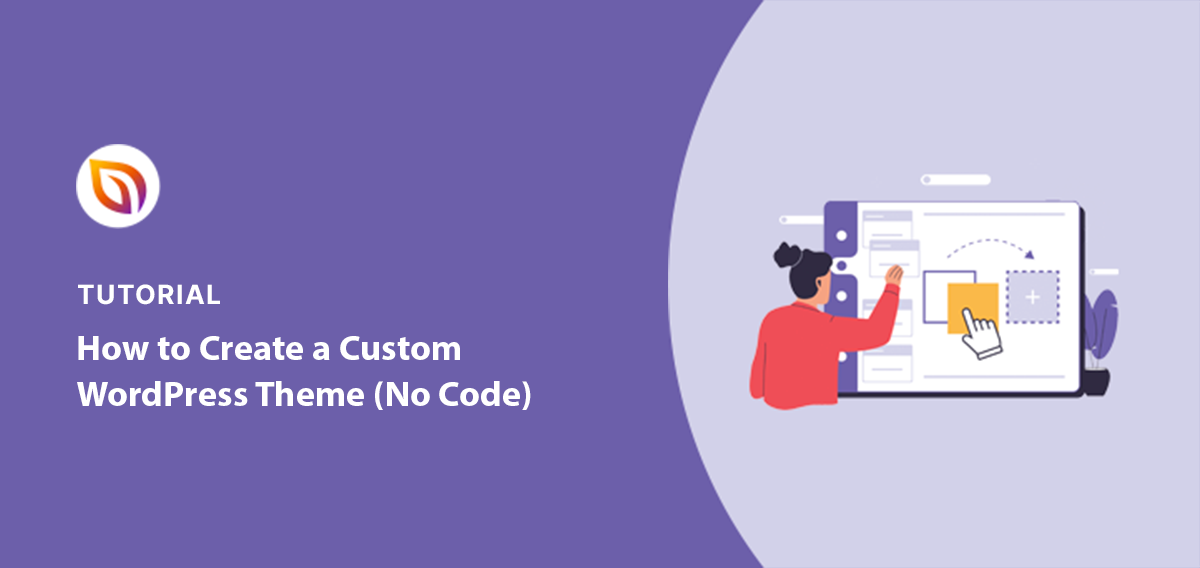My website is incredibly important to my business; it’s how people find me online. It’s often the first impression they get of my brand. When I first started, I used a standard WordPress theme. It was a good starting point, but it didn’t quite capture my brand’s unique personality.
I felt like I was constantly trying to force it to do things it wasn’t designed for. I realized I needed a website that looked and worked exactly how I needed it to, and that’s why I created my own custom WordPress theme. It wasn’t always smooth sailing, to be honest.
There were moments when I felt lost in the code and technical details. But, eventually, I figured it out, and I now have a website that’s a perfect fit. In this article, I’ll share my journey and guide you on creating your own custom theme step-by-step.
The Easiest Way to Build a Custom WordPress Theme:
- Step 1. Install SeedProd and Choose a Template
- Step 2. Customize the WordPress Header and Footer
- Step 3. Create a Custom WordPress Home Page
- Step 4. Create Blog Page & Single Post Templates
- Step 5. Create an About Page
- Step 6. Set Up A Contact Page
- Step 7. Adjust Global Theme Settings
- Step 8. Publish the Custom WordPress Theme
- More Ways to Build a Custom Theme
Why You Needed a Custom WordPress Theme
I needed a website to display my services, but I didn’t want a generic portfolio website. I felt uninspired looking at pre-made WordPress themes. They were either too busy or just not quite “me.”
Chances are you’re in a similar position. You need a custom WordPress theme because what’s already out there doesn’t really spark joy.
A custom theme gives you the freedom to create exactly what you want: dedicated sections for your work or products, a layout highlighting your approach, and a look and feel that screams, “This is ME!”
The only problem? Coding. 🤯
Like many people creating their first website, I didn’t know how to design a WordPress theme and had zero coding experience. Hiring someone for WordPress theme development seemed like the only option, but it wasn’t exactly budget-friendly. I was starting to feel stuck…
…until I learned about SeedProd.
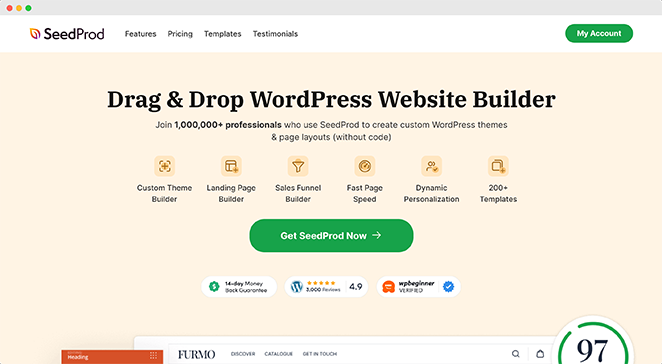
SeedProd is a WordPress page builder plugin that lets you build custom themes visually on your WordPress site, without writing any code. It’s like having a drag-and-drop website builder but with the power and flexibility of a custom theme.
You can choose from pre-designed templates and then easily customize everything — colors, fonts, layouts, you name it.
With this in mind, I decided to use SeedProd to build and customize a WordPress theme for my personal website. I even documented it in this step-by-step guide, so you can learn how to create a custom WordPress theme yourself.
Prepping for a Custom WordPress Theme Design
Before creating a WordPress theme with SeedProd, you’ll want to make sure you have a safety net. If you already have an existing website with content you want to keep, you should make a backup of your WordPress installation, just in case.
To avoid any theme development mishaps on your live site, you should also create a staging site. This gives you a separate, private environment to experiment with SeedProd and build out your theme without affecting your live website.
How to Build A Custom WordPress Theme from Scratch
Remember how I said I didn’t know how to code? Well, that wasn’t a problem at all. SeedProd made it incredibly easy to build a custom theme, step by visual step. Here’s how I did it.
Step 1. Install SeedProd and Choose a Template
First, get yourself the SeedProd Pro plan. It provides all the features you need (including the theme builder) at an affordable price.
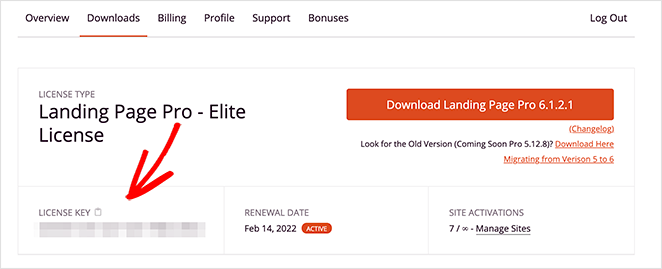
Once you have your license key, go to your staging site and install the plugin. Installing SeedProd is as simple as uploading the plugin file and clicking “Activate.”
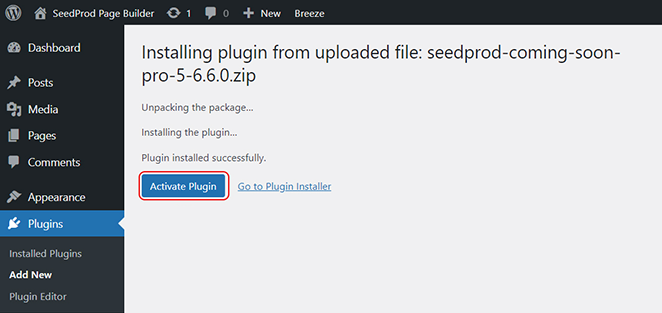
With the plugin active, go to the SeedProd menu in your WordPress dashboard and click on “Theme Builder.” Then, click the “Theme Template Kits” button to choose your starter theme.
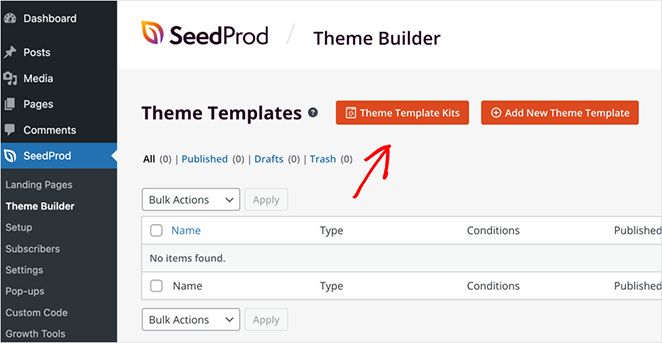
SeedProd has so many professionally designed block theme templates that I have to admit; even I was a little spoiled for choice.
You can filter them by “All”, or “WooCommerce” and sort them by popular, new, and even begin with a starter theme. Scroll through the template kits until you find a design that best fits the look or industry you’re going for.
Don’t worry if it isn’t perfect. You can customize every inch of it in the next step.
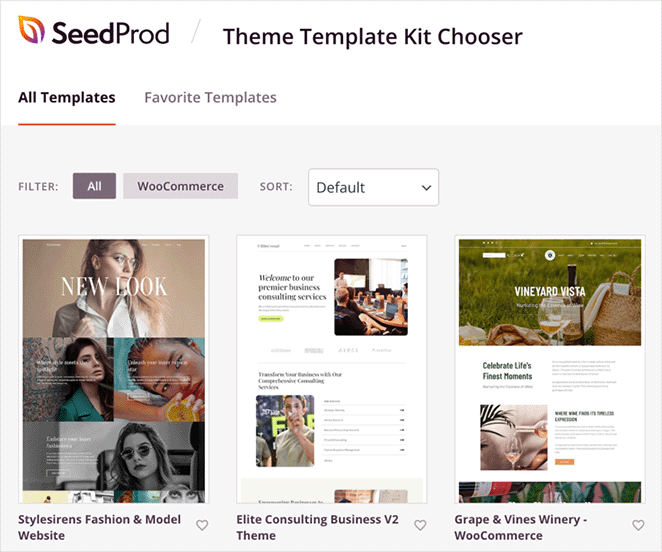
I finally settled on the Elite Consulting Business Theme. Its clean, modern look matched perfectly the vibe I was going for.
To import your theme file, hover your mouse cursor over the theme kit and click the checkmark icon.
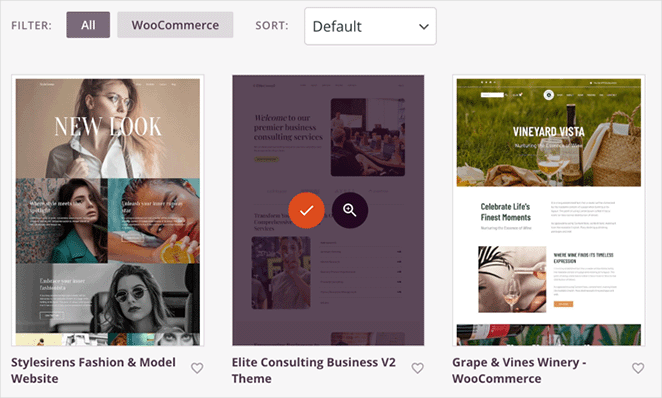
Click here to preview the template I selected for this design so you can compare it to the customized version.
After choosing a kit, you can see all the individual templates that make up the components of a WordPress theme. Mine included a homepage, header, footer, blog page, and sidebar for instance.
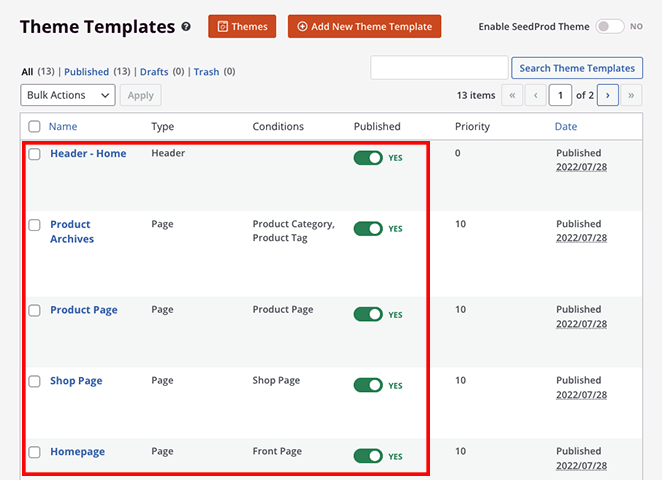
It also had custom templates for distinct theme sections, such as an awards section, a services page, a pricing table, a custom page template for products, and more.
Chances are you may not need all of these for your site. So, focus on what you need and delete the templates you don’t want by clicking “Trash.”
If you’re not comfortable with this, you can always turn off the “Published” toggle so that the template doesn’t appear on your website.
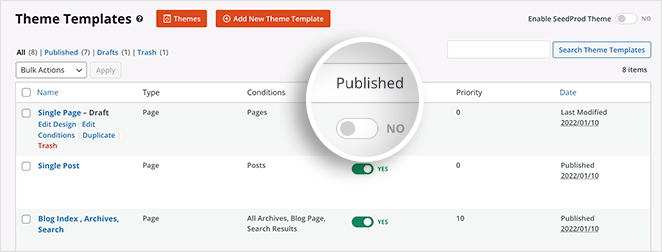
Step 2. Customize the WordPress Header and Footer
With your theme’s basic building blocks in place, you can start editing each theme section. For my site, I began with the header and footer sections.
To edit any theme section, you just need to hover over it and click the Edit Design link.
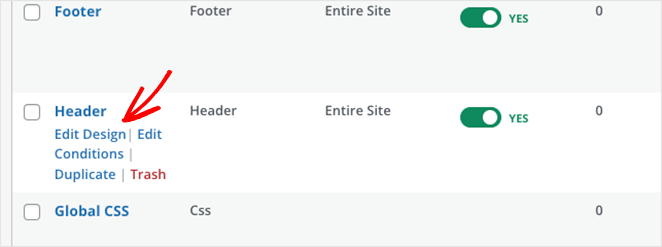
When you edit a theme section in SeedProd, you’ll go to its visual drag-and-drop builder. On this screen, you can customize your theme’s header by simply pointing and clicking.
The original header template had a three-column layout, which was a bit too busy for my taste. In this case, you can simply delete it and drag in a two-column layout block from the left-hand panel.
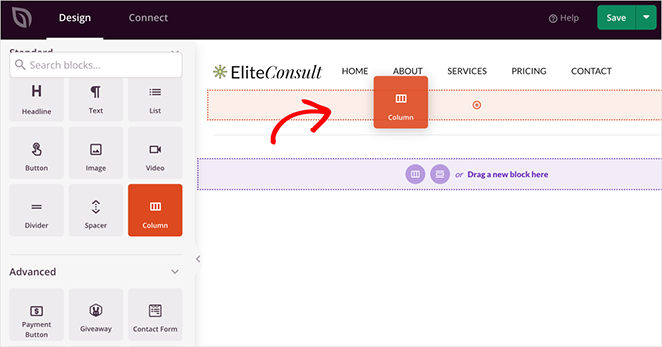
Adding a logo is also a breeze with the Image block – just select it from your media library and use the point-and-click controls to adjust its size and placement.
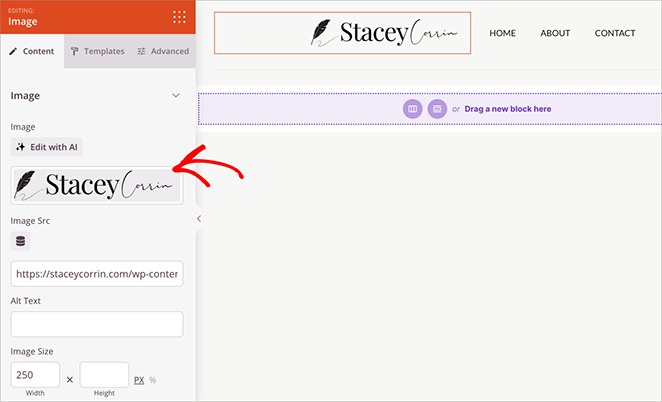
For the navigation menu, you can use SeedProd’s Nav Menu block and choose the “Simple Menu” setting. This allows you to easily create the exact menu structure you have in mind.
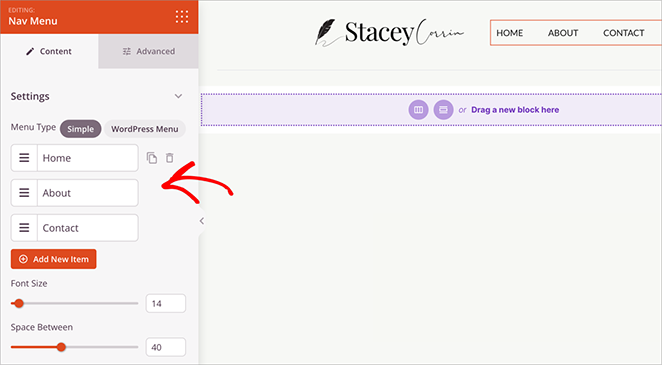
Once you’re happy with your header, go ahead and save your changes. Then, head back to the theme builder, and open the Footer template to customize the footer section.
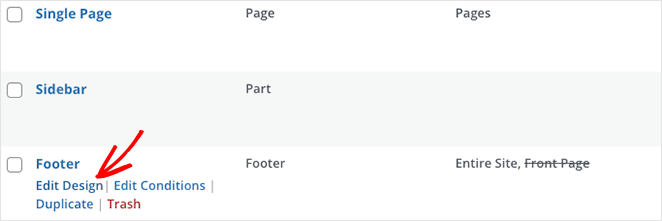
The original footer in my template had a bit more information than I needed, so I simplified it by deleting unnecessary blocks.
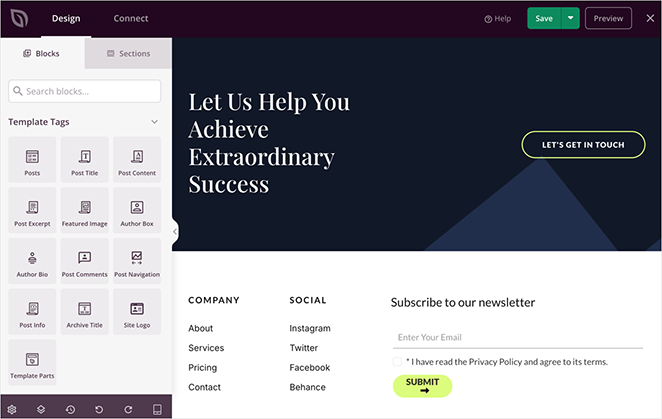
I kept the company info and social media menu items but centered them for a more balanced look. Then, I just swapped out the placeholder content with my own.
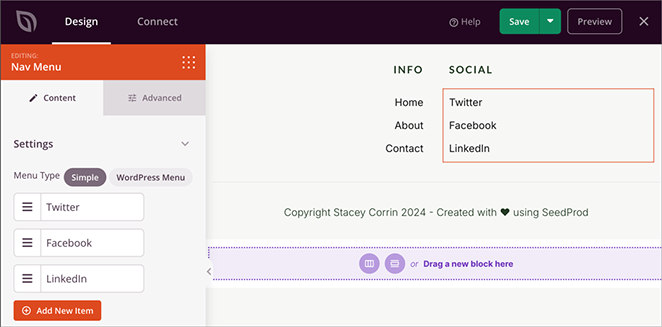
Make similar changes to your footer template to achieve the look you want for your custom theme.
Once your header and footer look sleek and stylish, it’s time to tackle the heart of your website: the homepage. Remember, you can find your template files under SeedProd » Theme Builder.
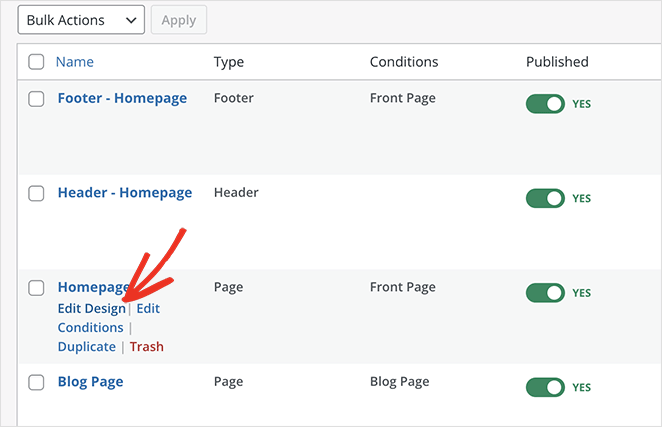
Step 3. Create a Custom WordPress Home Page
Your main goal when customizing the homepage is likely to create a strong first impression, show your expertise, and provide potential clients or customers with compelling reasons to choose you or your business.
Personally, I liked the overall layout of the Elite Consulting Business theme’s homepage, but I wanted to simplify it further and add my personal touch.
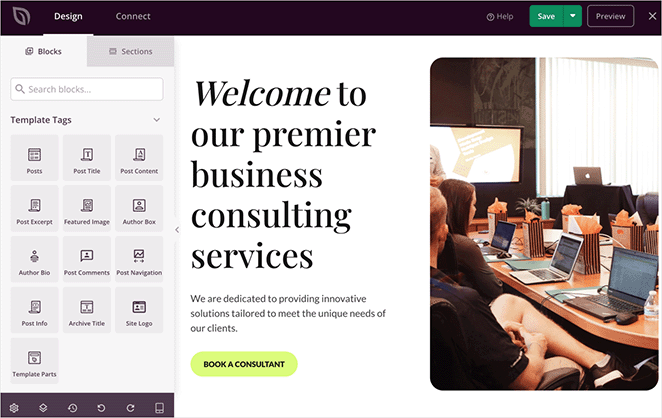
I kept the hero section at the top, as it’s a great way to make a bold statement. I simply swapped out the default image for one that better reflected my brand, and updated the heading and description.
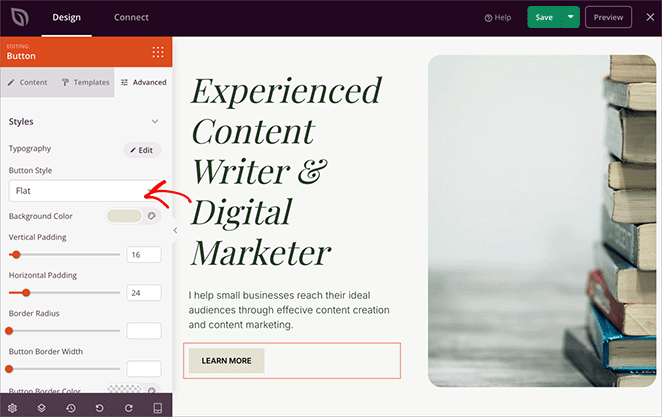
Likewise, I also tweaked the CTA button styling. You can do this by clicking on the block’s advanced settings. It provides you with access to a color picker, where you can select a new background color and round the button’s corners for a softer look.
Beneath the hero section, I added a five-column section using Image blocks to showcase the logos of brands I’ve worked with.
You can use this approach to build credibility and demonstrate your experience.
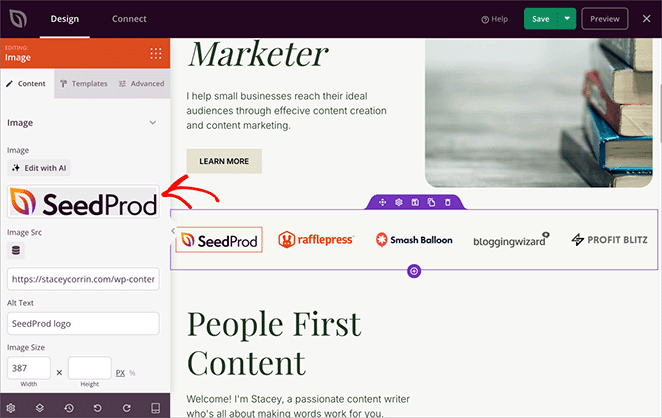
The original design included Counter blocks, which I loved, so I kept them but updated the statistics to reflect my own achievements and milestones.
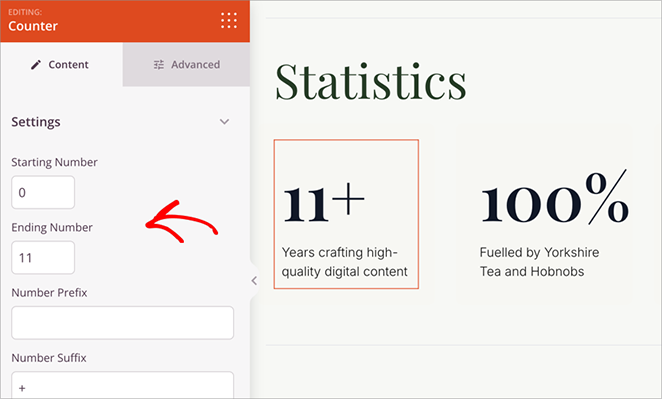
If you want to add social proof to your site, you can create a new section using SeedProd’s Testimonial block. This block allows you to create an eye-catching carousel slider displaying client testimonials, complete with their headshots.
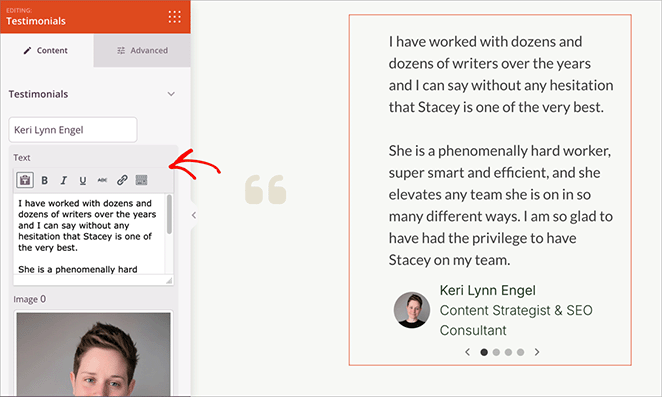
Finally, to highlight my writing skills, I built another new section with multiple columns. Each column contained an Image block (displaying a thumbnail of a published article) and a Heading block linked to the full article on external websites.
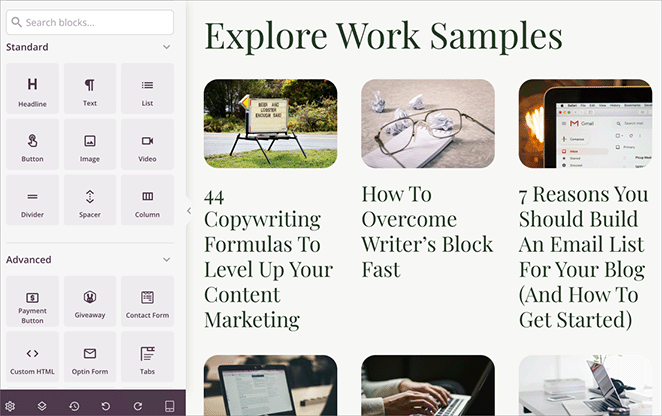
Alternatively, you can use the Gallery and Advanced Gallery blocks to display your portfolio.
With a few clicks and drags, your homepage will start to look exactly how want it.
Step 4. Create Blog Page & Single Post Templates
Okay, so I didn’t actually need this step because I wasn’t planning on having a blog on my website. But I know many of you will want to share your thoughts and expertise with the world, so here’s a quick rundown of how SeedProd makes it easy to create stunning blog pages and single post templates.
Blog Page Template
Your blog page template can be found in the theme templates list under “Blog Index, Archives, Search” or, in my case, “Blog Page.” Like the previous custom page template, you can customize it by clicking the “Edit Design” link.
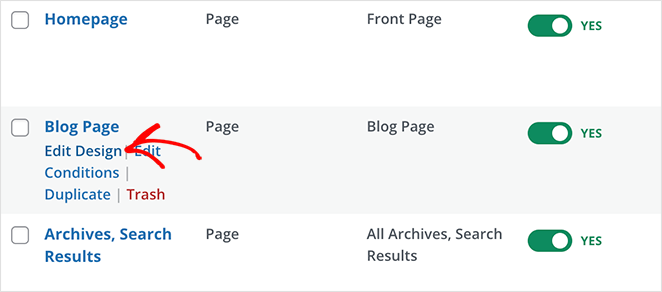
Here, you can customize how your blog posts are displayed – you can choose to show featured images, excerpts, author information, and more.
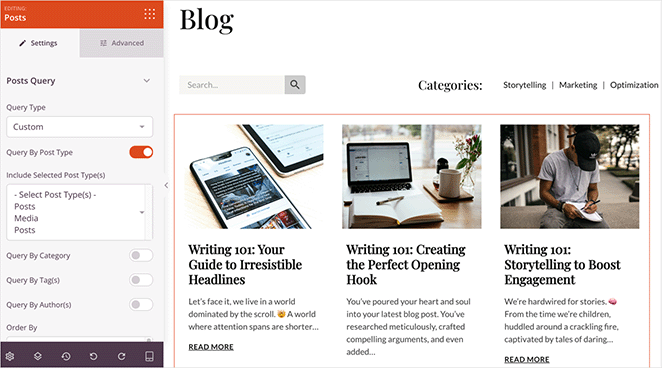
You can also add elements like a search bar, social media sharing buttons, or even a call to action to encourage visitors to explore further.
Single Post Template
Just like the blog custom page template, you can edit and customize the single blog post template.
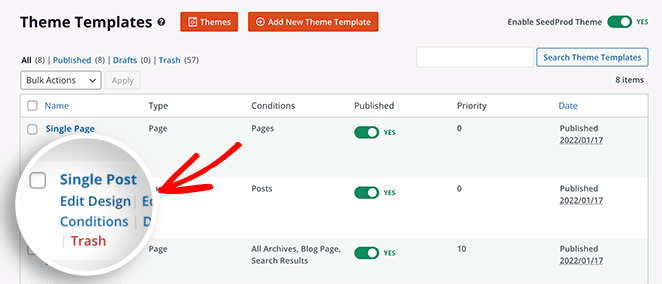
For a consistent look, SeedProd lets you style the display of elements like the post title, featured image, meta description, and even the author bio.
These are called template tags on WordPress. They automatically pull data from your site without you having to manually create them.
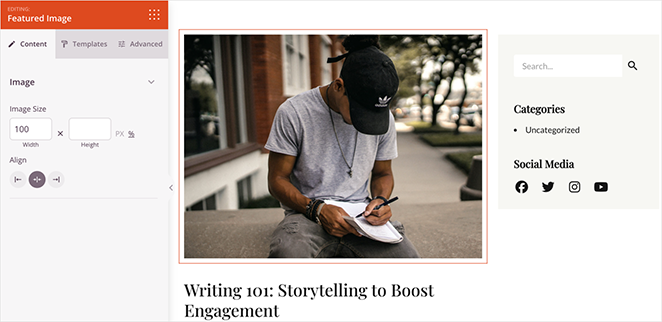
For example, with the Featured Image template tags, you can automatically display featured images on your single blog page.
Step 5. Create an About Page
After the homepage, the About page is arguably the most important part of any personal website. It’s where potential clients and collaborators get to know the person behind the services. I wanted mine to feel authentic and engaging and give a clear picture of who I am and what I offer.
The Elite Consulting Business theme already included a basic custom WordPress page template for an about page, which I could access by going to Pages » All Pages in my WordPress dashboard and clicking “Edit with SeedProd.”
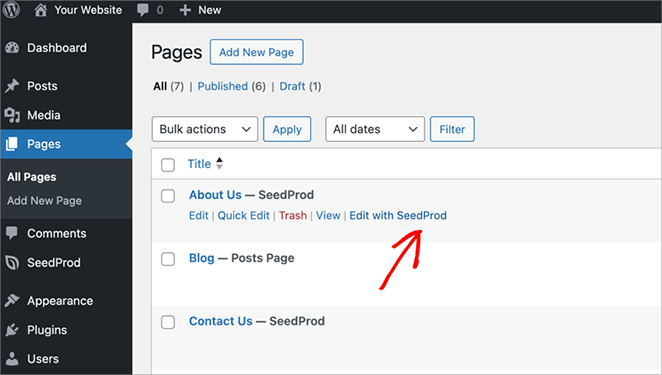
I decided to keep the first two sections of the original design, which focused on my work experience and the services I provide. I just swapped out the placeholder content and images for my own.
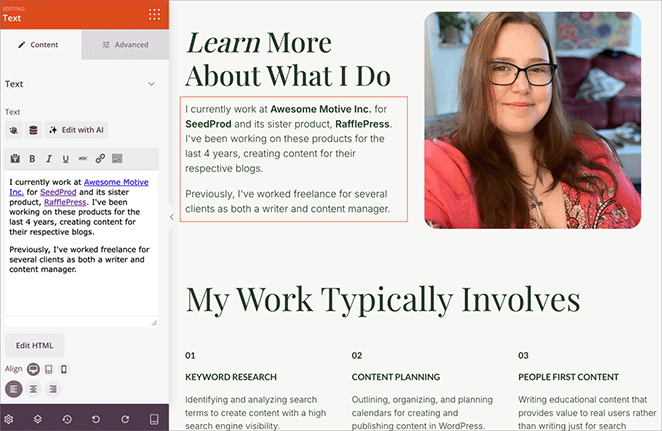
Next, I wanted to showcase my certifications to build credibility. This is where SeedProd’s Template Parts came in handy.
Think of template parts as pre-made sections that you can insert and reuse across different pages of your website – a huge time-saver. The theme came with a template part called “Awards and Recognition.”
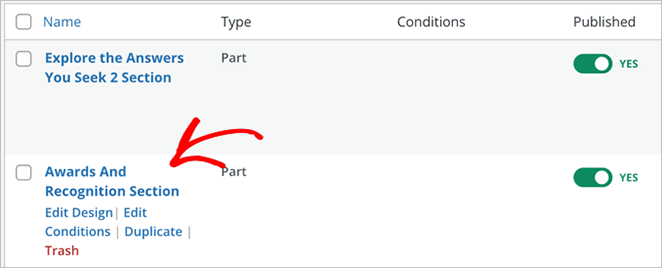
I simply edited this template to include my certifications, then easily inserted it into my “About” page.
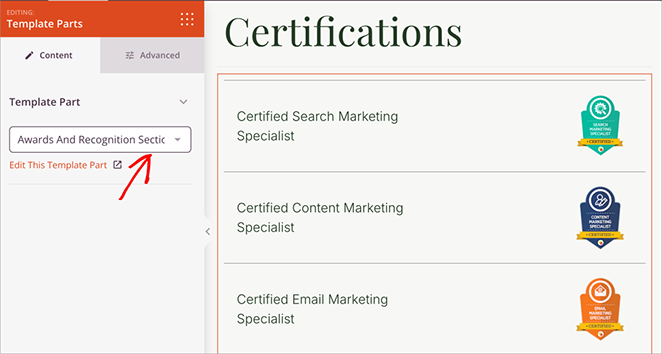
To wrap it up, I created a final section with a more personal touch. I shared some of my hobbies, where I live, and other tidbits that would help visitors connect with me on a more personal level.
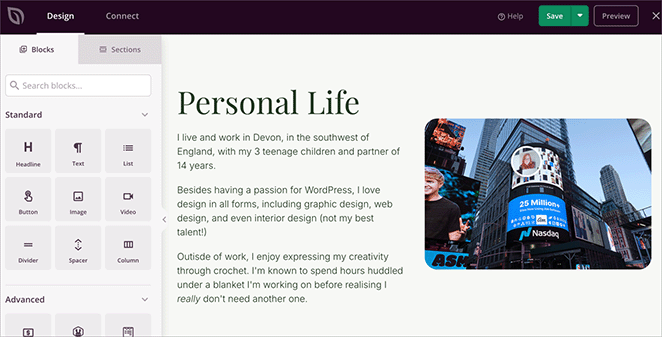
Step 6. Set Up A Contact Page
The last thing I wanted was a cluttered and confusing contact page. While the Elite Consulting Business theme came with a pre-built contact page, it felt a bit overwhelming.
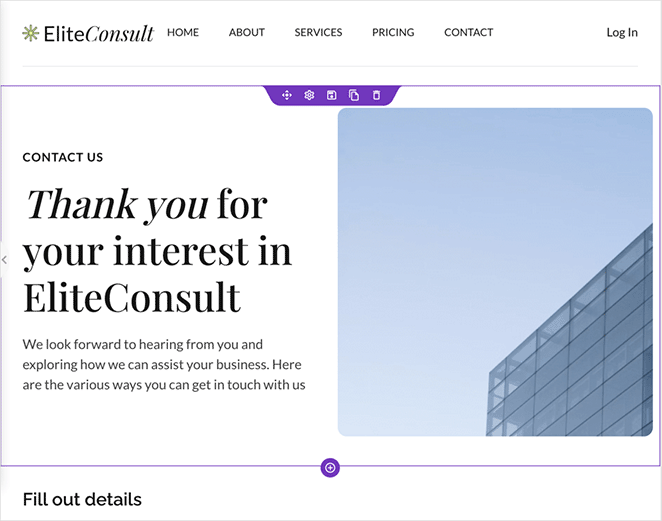
I decided to simplify things drastically. I deleted most of the default content and replaced it with SeedProd’s Contact Form block. This block makes it super easy to integrate with WPForms, one of the most popular WordPress form builder plugins.
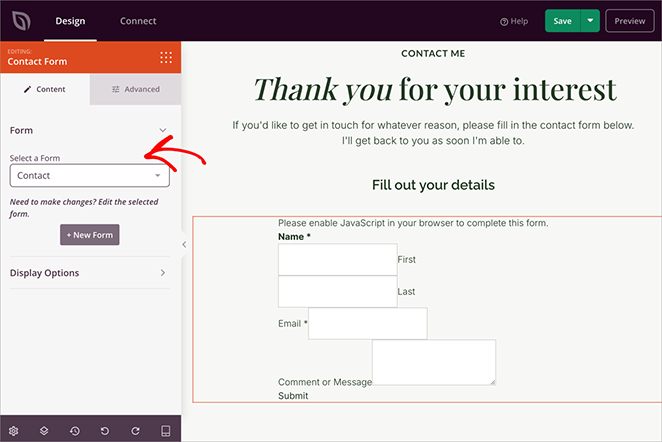
Quick note: WPForms doesn’t come bundled with SeedProd, but you can download the free version of WPForms from the WordPress plugin directory – it has everything you need for a basic contact form.
With WPForms installed, you can create a contact form directly within SeedProd – no need to fiddle with complicated settings or shortcodes.
I did notice that the form’s styling looked a bit off in the page builder preview. However, once I published the page, the form magically snapped into place, looking perfectly uniform and professional.
Step 7. Adjust Global Theme Settings
My website was really starting to come together. Now, it was time to add those final touches that would make it look super polished and professional. Enter SeedProd’s global settings.
The Global CSS template is in the theme templates list—just click “Edit Design” to open it. This is your command center for controlling the overall look and feel of your website.
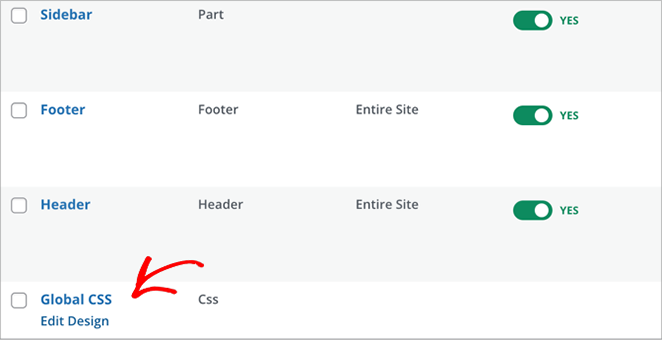
Colors
First, you’ll want to ensure color consistency across every page. SeedProd makes this easy by letting you define global colors for everything from headers and text to buttons, links, and backgrounds.
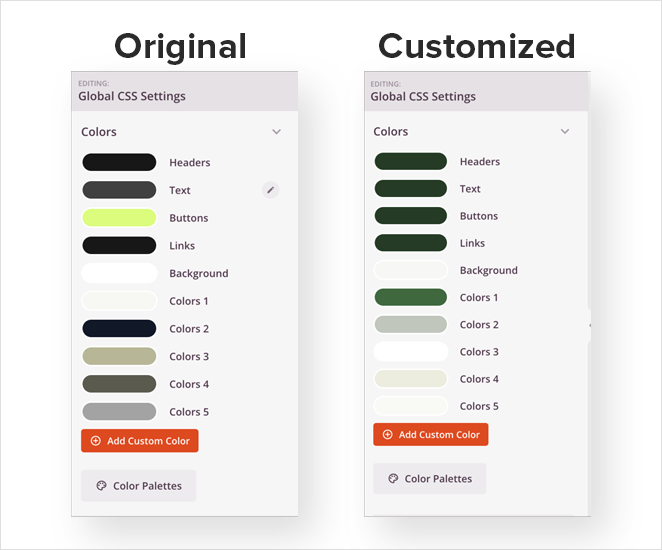
Fonts & Typography
While I liked the default font of the Elite Consulting Business theme, I wanted to tweak the font weights and colors for headings and links to better match my brand aesthetic.
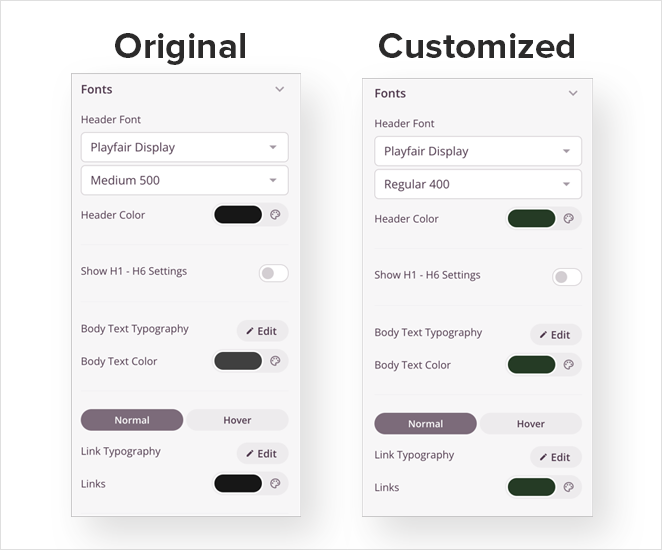
Background
To keep things consistent, I changed the overall page background color. SeedProd even lets you add a background image here if you want to get fancy.
Buttons
Buttons are crucial for calls to action, so make sure they stand out. Played around with different font styles, colors, and border radius until you find a look that feels right.
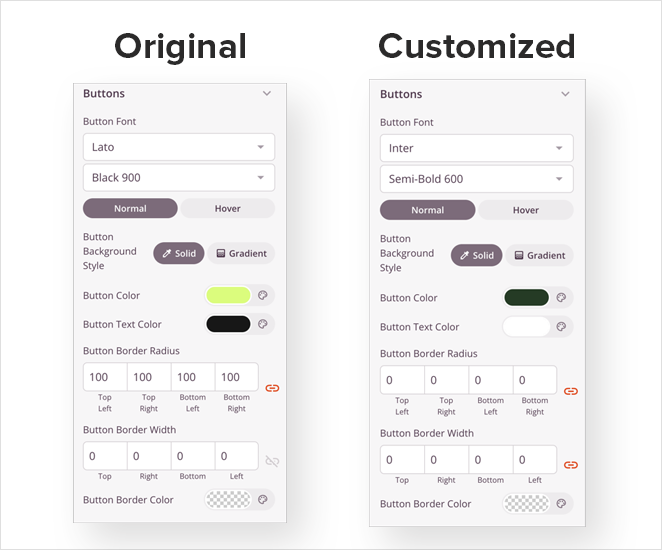
Custom CSS
SeedProd even gives you the option to add your own Custom CSS. This is where things get a tiny bit technical, but it gives you even more control over your design.
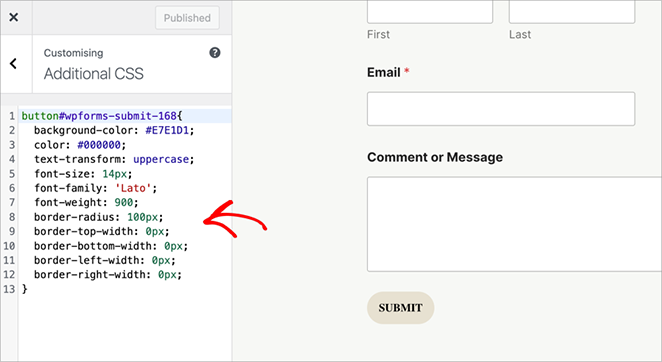
For example, I used a snippet of custom CSS to make the WPForms form submit button match the styling of my other buttons.
Step 8. Publish the Custom WordPress Theme
After putting so much care into designing your custom WordPress theme, don’t skip the final checks. Use the built-in preview feature to double-check how everything looks on different screen sizes – from desktops to tablets to smartphones.
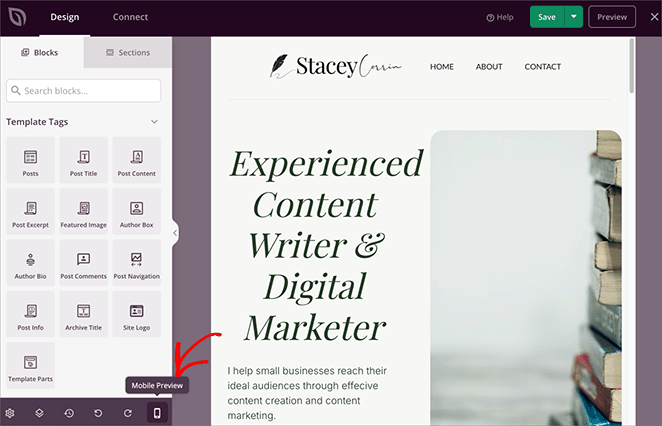
You’ll want to make sure your theme looks fantastic, no matter how people were viewing it.
Of course, you should also test your interactive elements. Submitted a test message through your contact form (and do a little victory dance when it lands in your inbox! 🎉)
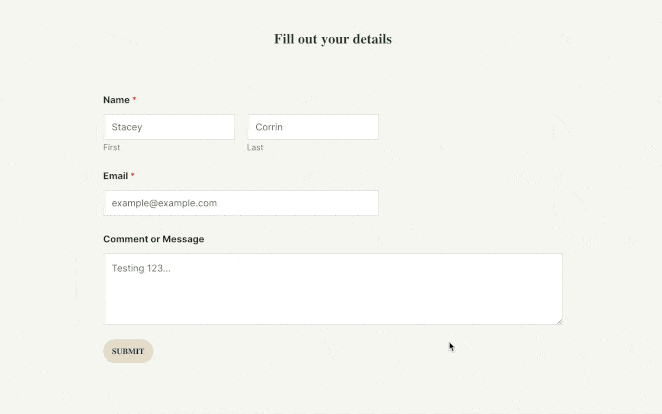
I clicked every button and menu link, just to be certain they led to the right places.
Finally, the moment of truth. Head back to the SeedProd Theme Builder, take a deep breath, and find the “Enable SeedProd Theme” toggle in the top-right corner. With one satisfying click, switch it to the “on” position.
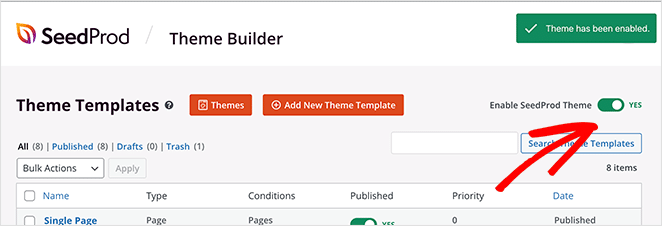
Your custom WordPress theme is LIVE! You can see the full custom theme I created for this guide here.
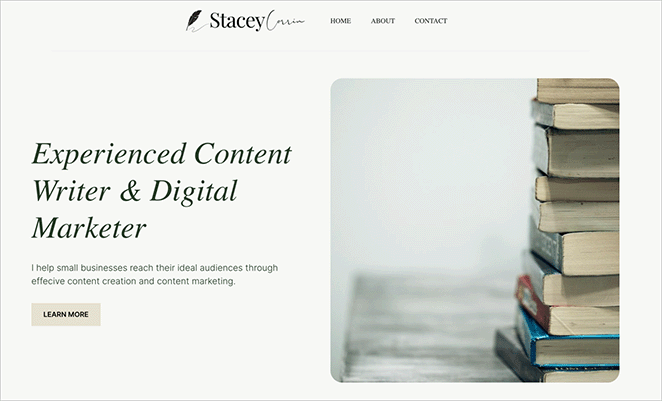
More Ways to Build a Custom Theme
Now, I understand that not everyone reading this guide will want to follow my process for creating custom templates and themes. With this in mind, I’ve researched a few other ways to build a professional website design.
| Method | Difficulty | Coding? | Best For |
|---|---|---|---|
| Traditional Coding | Advanced | Yes (PHP, HTML, CSS, JS) | Developers, agencies |
| Underscores (_s) | Intermediate | Yes (PHP, CSS) | Developers learning theme development |
| Child Themes | Beginner/Intermediate | Some CSS | WordPress enthusiasts |
| Block Themes | Intermediate | No | Modern WordPress users |
After trying different methods, I still think SeedProd is the best choice for most people. Why? It’s simply easier.
You don’t need to learn code, you can build a professional-looking site in hours, and you won’t get stuck dealing with technical problems. If you’re busy running your business or creating content, SeedProd lets you build exactly what you want without the headaches of traditional WordPress development.
Frequently Asked Questions
Create a Custom Theme for Any WordPress Website
If you want to make a specific type of website, you may like these WordPress theme tutorials:
- How to Create a Personal Trainer Website
- How to Build a Church Website in WordPress
- How to Design a Restaurant Website
- How to Set Up an Online Store in WordPress
- How to Create a Photography Website
- How to Create a Real Estate Website
- How to Create an Author Website in WordPress
- How to Make a Wedding Website
Thanks for reading! I’d love to hear your thoughts, so please feel free to leave a comment with any questions and feedback.
You can also follow us on YouTube, X (formerly Twitter), and Facebook for more helpful content to grow your business.

